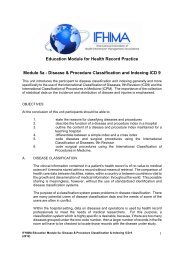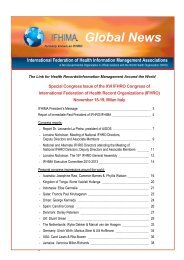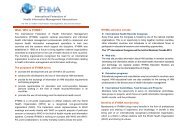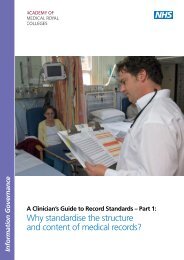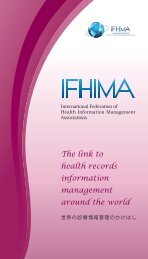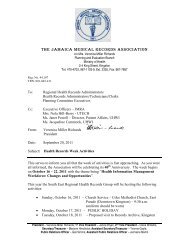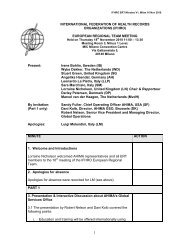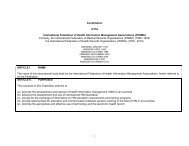Learning Packages for Medical Record Practice - ifhima
Learning Packages for Medical Record Practice - ifhima
Learning Packages for Medical Record Practice - ifhima
Create successful ePaper yourself
Turn your PDF publications into a flip-book with our unique Google optimized e-Paper software.
SUMMARY:<br />
1) Advantages of microfilming include:<br />
� good alternative <strong>for</strong> inactive records<br />
� reduced storage space required<br />
� usually acceptable as legal evidence<br />
2) Disadvantages include:<br />
� cost<br />
� accessibility<br />
� possible fire hazard and deterioration over time.<br />
c) Image-based storage systems<br />
Another newer option <strong>for</strong> long-term record storage is an image-based<br />
system. In this system, a document scanner scans the original record<br />
and creates a digital picture. Once scanned, the images are stored on an<br />
optical disk, which allows easier and faster retrieval of individual patient<br />
records.<br />
There are two basic options <strong>for</strong> record identification, alphabetic and numeric. Which<br />
system is chosen is based upon the size and activity of the file. There are several types<br />
of numeric systems to choose from. The type of record identification system<br />
determines the type of filing system that may be used, such as alphabetic, straight<br />
numeric or terminal digit. The most important aspect of determining the filing system to<br />
be used is the ease in retrieval.<br />
Written policies and procedures must be in place to control the request, retrieval, and<br />
return of health records. These controls may be in a manual system or an automated<br />
record tracking system.<br />
Various options are available <strong>for</strong> storage of paper-based health records. Active and<br />
inactive files may require different storage solutions, such as offsite or commercial<br />
storage facilities. File folders offer various features, such as color-coding to identify the<br />
health record number, rein<strong>for</strong>cement, and fasteners. Various options are available in<br />
choosing the filing equipment to be used, including cabinets, open shelves, and mobile<br />
shelves.<br />
<strong>Record</strong> retention policies must be written that meet applicable legal requirements and<br />
the individual needs of the facility. The Governing Board must approve the record<br />
retention schedule.<br />
REVIEW QUESTIONS:<br />
IFHIMA Education Module 3: <strong>Record</strong> Identification Systems, Filing and Retention of Health <strong>Record</strong>s<br />
(2012)<br />
27



